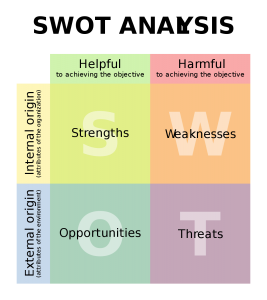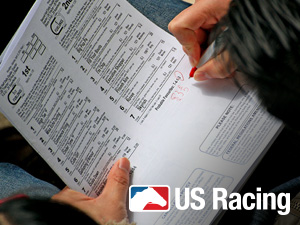By Ray Wallin
If you are involved with a business or business strategy you have likely been part of or heard about SWOT analysis. For those of you that are not familiar with a SWOT analysis, it is an evaluation of strengths, weaknesses, opportunities, and threats to an organization. Yet we can look at SWOT from a horse racing perspective to help you improve your handicapping.
Businesses use SWOT analysis to evaluate new products, services and markets when looking at the best way to achieve growth. It is a useful tool to understand your organizations current situation. By applying these simple concepts to your handicapping, you will maximize the value of each dollar wagered by avoiding riskier and ill-advised  betting opportunities while focusing on what you know will return a profit.
betting opportunities while focusing on what you know will return a profit.
Strengths
The first thing to do during a SWOT analysis is identify what skills and capabilities you have and ask yourself “what do you do particularly well?”
If you hang around the track enough, you’ll hear the regulars talk about what types of races they excel in betting on. When I used to spend my weeknights on the second floor of the old Meadowlands grandstand, one regular had a real niche. While he bet on most any track and race, Tommy Turns had a race that was his bread and butter play. Most of us passed on playing the races at Charles Town but Tommy Turns salivated at the mile-and-a-sixteenth races offered at this bullring.
What is unique about the 8 ½-furlong races at Charles Town is that due to the small nature of the track, these races are run around three turns instead of the typical two turns for routes at this distance over most other courses. There were many nights when no races were carded over 7 furlongs, which is a two turn distance, but when there was a three turn mile-and-a-sixteenth race Tommy was all over it.
While Tommy played his handicapping factors close to the vest, we watched him win more often than not in these troubling three turn routes. Most of us would pass these races, but Tommy could decipher and win these races consistently.
Maybe you do well with turf races and understand pedigree better than most or you can model the pace scenarios of claiming races or routes better than sprints. The key is that you recognize where your strengths lie, whether it is race conditions, distance, surface, or the type of bets you are placing.
Weaknesses
The next thing to do is to look at what you do poorly and ask yourself “what processes can you improve?”
In my formative years on the grandstand apron at Monmouth Park with my late Uncle Dutch in the 1990’s, I had a reckoning. I struggled assessing horses shipping in from Suffolk Downs. I couldn’t figure them out. I could analyze horses shipping in from Philadelphia Park (now Parx) or Delaware Park and understood the horsemen at those meets, but could not do the same for horses shipping down from Suffolk Downs.
To better assess Suffolk shippers and stop losing to them, I started to track the trainers, jockeys, class levels, and eventually also established a track-to-track adjustment factor to help figure pace. This approach would turn my Achilles’ heel into an eventual strength until Suffolk stopped running their full meets and being a factor in the New Jersey circuit.
Opportunities
When you consider opportunities, you need to think about where you can apply your strengths and ask yourself “are there new markets for my strengths?”

Horse racing betting slip.
When I set out to revamp my handicapping approach in the late 1990’s, I knew that one part of my game had always been consistent. I was good at establishing the probable pace scenarios of a race. I had been having success with picking a high percentage of winners and doing OK with exactas and limited trifectas.
Based on my ability to consistently pick winners, I saw that there was an opportunity for me to start focusing more on horizontal wagers or playing multi-race wagers such as the double, pick three, or pick four. As I started to track my performance on these multi-race wagers, I found out I was outperforming the exactas and trifectas by a large margin. This opened up a new avenue for me to bet. While I would still play my top contenders to win, I could use the outcomes of my probable pace scenarios to cover multiple outcomes in the same race. By using more contenders per race, I could string winners in more consecutive races than I could find horses that finished in second place.
By taking your strengths and applying it to a new market or wagering type you can maximize the performance of your handicapping.
Threats
The last part of the analysis you need to consider is what could cause you to lose your edge or stop you from performing at high level.
My late Uncle Dutch was ahead of his time when he spent his days at Monmouth Park. The Racing Form didn’t include the trainer and jockey stats or pedigree information they do now. Dutch kept a black and white marble composition pad with him that included his own trip notes and stats on everything you see now in print. He’d track how jockeys performed at different distances, over different surfaces, and for various trainers. He’d track the trainer’s performance by class, distances, and under a variety of conditions such number of starts off of a layoff or off a claim. He would find the predictable methods of the horsemen that helped them race a horse into shape.
As the past performances evolved to start showing more information, Dutch lost his edge. The information that he had accumulated was now made publicly available. This was a threat to his success that he never considered. While it was still valuable information horses were bet down and his profit margin shrunk.
The key to threats is evolving your approach and trying to stay one step ahead of the crowd.
When you step back and look at SWOT analysis, you can see how powerful it is for such a simple strategy. By leveraging your handicapping strengths, improving your weaknesses, minimizing threats, and taking advantage of opportunities, you will be fast on your way to fulfilling your dream of making your living playing the races.
Recommended: 5 Ways To Become A Top Handicapper

Ray Wallin is a licensed civil engineer and part-time handicapper who has had a presence on the Web since 2000 for various sports and horse racing websites and through his personal blog. Introduced to the sport over the course of a misspent teenage summer at Monmouth Park by his Uncle Dutch, a professional gambler, he quickly fell in love with racing and has been handicapping for over 25 years.
Ray’s background in engineering, along with his meticulous nature and fascination with numbers, parlay into his ability to analyze data; keep records; notice emerging trends; and find new handicapping angles and figures. While specializing in thoroughbred racing, Ray also handicaps harness racing, Quarter Horse racing, baseball, football, hockey, and has been rumored to have calculated the speed and pace ratings on two squirrels running through his backyard.
Ray likes focusing on pace and angle plays while finding the middle ground between the art and science of handicapping. When he is not crunching numbers, Ray enjoys spending time with his family, cheering on his alma mater (Rutgers University), fishing, and playing golf.
Ray’s blog, which focuses on his quest to make it to the NHC Finals while trying to improve his handicapping abilities can be found at www.jerseycapper.blogspot.com Ray can also be found on Twitter (@rayw76) and can be reached via email at [email protected].


